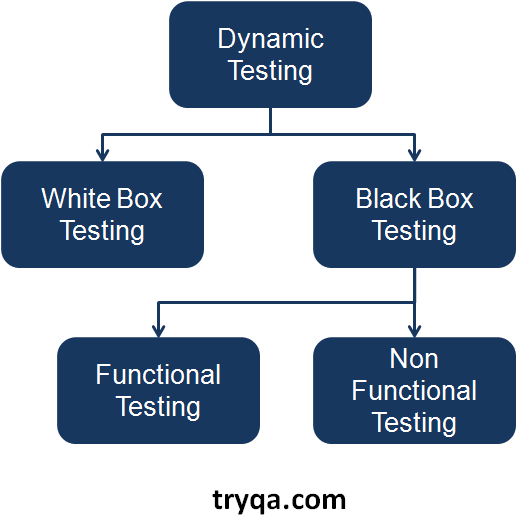- Specification-based testing technique is also known as ‘black-box’ or input/output driven testing techniques because they view the software as a black-box with inputs and outputs. [Read more…] about What is black-box, Specification-based, also known as behavioral testing techniques?
What is Dynamic testing technique? Examples, Types, Advantages & Disadvantages
Dynamic testing technique is the type of testing that validates the functionality of an application when the code is executed / by executing the code. In simple terms dynamic testing is performed by actually using the application and seeing if a functionality works the way it is expected to. There is also something called ‘static’ testing. Learning about static testing helps understand dynamic testing better, so let’s summarize static testing first.
What is Static Testing?
Static testing as the name itself suggests is static in nature, which also means there are no changing conditions or parameters. In other words, this is performed without executing the code.
For example, when you are verifying a document or testing a document, you will go through the document, review it and then suggest or make changes.
Also, when there is a code review / walkthrough, the development team goes over the code step by step and checks whether the code written is according to the development standards and also it traverses through correctly to achieve the results desired.
Since, we are not changing anything in the documents, but also reviewing them, it is called static testing. We are testing, but it is static in nature.
Other examples for static testing are review of test strategy document, test plan document, test case walkthrough, Inspection of the code etc.
What is Dynamic Testing?
Now, let’s look at Dynamic testing. The name itself suggests that it is “Dynamic” in nature, which means changing. This is the kind of testing that we do with changing values or conditions by executing the code.
This involves testing the application in real-time by giving inputs and examining the result or the output value of behavior.
Dynamic Testing Example
The easiest example to understand this is the login functionality of any application, like Google’s gmail.com. If we are creating an account, and a password for the account, you would have certain rules for creating a strong password.
For instance, 8 characters long, needs to have a capital letter and at least one special character.
These are nothing but different conditions or parameters and if the user inputs any value that deviate from these rules, the application should either warn or reject.
If you are testing this functionality as an example, you would input all the conditions required to test this and then validate the output.
You would also input the non-working parameters, for example, input a 4-character password and verify if there is an error that is thrown. This is all part of Dynamic testing.
Types of Dynamic Testing
Dynamic testing is broadly classified into two types.
- Whitebox testing – Whitebox testing looks at the internal workings of the code. For this type of testing, the tester should know the code development, review and be able to interpret the code.
- Blackbox testing – Blackbox testing looks at only the functionality of the Application Under Test (AUT). This does not require the tester to know the implementation details or be able to interpret the inner workings of the code. This is the type of testing mostly done by the QA department.
Since we are interested more in learning about Blackbox testing, we also need to know that there are again two broad types of Blackbox testing.
- Functional Testing – As the name itself suggests, this is the type of testing that validates the functionality of the application.
- Non-Functional Testing – Non-Functional testing covers the aspects of performance, recovery, compatibility testing etc. These are non-functional in nature. And there may be a separate division in the organizations to do the non-functional testing.
Dynamic testing is performed at different levels. Let’s look at the basic definition of what each testing means.
- Unit testing – Simply put, the testing done by the developers right after they build the code to ensure their code is working as they expected and according to the requirements.
- System testing – This is the type of testing the QA department does after the code has been built and this covers the entire system/application in terms of testing. The QA team does thorough testing to make sure the functionality of the system is in-line with the requirements.
- Integration testing – This is a joint effort (in most companies) by the QA and development teams to make sure each individual module (after being tested) then connected to other modules or systems is still working as expected. This is basically the testing for the entire workflow from start to end.
- User Acceptance Testing (UAT) – This is done by the UAT team (User Acceptance Testing) with the aid of QA team. The business users write their own test cases and perform testing more geared towards the user’s perspective unlike what the QA does, more toward system’s perspective.
There are advantages to using dynamic testing. At the same time there are some disadvantages. Let’s look at the advantages first.
Advantages of Dynamic Testing
- Dynamic testing is thorough, which looks at in-depth functionality of the application so the quality is of highest standards.
- Dynamic testing process is well-established and hence the application is tested from user’s and business perspective thus increasing the quality standards.
- Complex defects can be caught which may have escaped the review processes
- Dynamic testing can be automated using tools
Disadvantages of Dynamic Testing
- Since Dynamic testing follows a complex detailed process, it takes time.
- It is time consuming and it costs more money to the organizations because of the need for the resources and time.
- Dynamic testing is usually performed after coding is completed and hence defects are discovered later in the lifecycle
In a nutshell, Dynamic testing technique is the type that is followed in all the organizations today. It is used as a tool that the QA can rely on and has successfully shown results of higher quality when followed properly in organizations. This is extremely useful technique in software testing.
What is Static testing technique?
- Static testing is the testing of the software work products manually, or with a set of tools, but they are not executed. [Read more…] about What is Static testing technique?
What are the categories of test design techniques?
A test design technique basically helps us to select a good set of tests from the total number of all possible tests for a given system. There are many different types of software testing technique, each with its own strengths and weaknesses. Each individual technique is good at finding particular types of defect and relatively poor at finding other types. [Read more…] about What are the categories of test design techniques?
What is test design technique?
A test design technique basically helps us to select a good set of tests from the total number of all possible tests for a given system. There are many different types of software testing technique, each with its own strengths and weaknesses. Each individual technique is good at finding particular types of defect and relatively poor at finding other types. [Read more…] about What is test design technique?